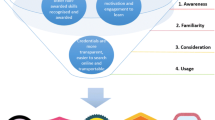Abstract
Digital badges provide new affordances for online educational activities and experiences. When used with points and leaderboards, a badge can become a gamification element allowing learners to compete with themselves or others, and to know how close they are to accomplishing a goal and acquiring its accompanying reputation. In this role, badges motivate continued engagement, which increases time on task and supports skill acquisition through performance. Learning outcomes signified by badges can also be displayed in an e-portfolio or on web sites and are highly transportable to social media sites. In this role they summarize achievement and signal accomplishment. With these characteristics, digital badges have the potential to become an alternative credentialing system, providing visible recognition in digital symbols that link directly via metadata to validating evidence of educational achievements in public displays. This paper will trace the brief history of digital badges, define what they are, give examples of their use, and discuss their educational affordances.

Similar content being viewed by others
References
Abramovich, S., Schunn, C., & Higashi, R. (2013). Are badges useful in education?: It depends upon the type of badge and expertise of learner. Educational Technology Research and Development, 61(2), 217–232. doi:10.1007/s11423-013-9289-2.
Baker, E. L. (2007). 2007 Presidential address the end(s) of testing. Educational Researcher, 36(6), 309–317. doi:10.3102/0013189X07307970.
Baker, D. P. (2011). Forward and backward, horizontal and vertical: Transformation of occupational credentialing in the schooled society. Research in Social Stratification and Mobility, 29, 5–29.
Davidson, C., & Goldberg, D. (2009). The Future of Learning Institutions in a Digital Age. Chicago: John D. and Catherine T. MacArthur Foundation.
Duncan, A. (2011). Digital badges for learning. Ed.gov. Washington D.C.: U.S. Department of Education. Retrieved from http://www.ed.gov/news/speeches/digital-badges-learning. Accessed 9 Nov 2013.
Gibson, D. (2004). E-Portfolio Decisions and Dilemmas. In Society for Information Technology in Teacher Education Annual Conference (pp. 135–145). Atlanta, GA: SITE.
Gibson, D. (2006). Elements of Network-Based Assessment. In D. Jonson & K. Knogrith (Eds.), Teaching Teachers to Use Technology (pp. 131–150). New York: Haworth Press.
Gibson, D. (2012). Game Changers for Transforming Learning Environments. In F. Miller (Ed.), Transforming Learning Environments: Strategies to Shape the Next Generation (Advances in Educational Administration, Volume 16) (pp. 215–235). Emerald Group Publishing Ltd. doi:10.1108/S1479-3660(2012)0000016014.
Halavais, A. M. C. (2011). A genealogy of badges: inherited meaning and monstrous moral hybrids. Information, Communication & Society, 15(3), 354–373. doi:10.1080/1369118X.2011.641992.
Hintz, R. (2009). Science education in the boy scouts of America. (Electronic Thesis or Dissertation). Retrieved from https://etd.ohiolink.edu/. Accessed 9 Nov 2013.
International Standards Organization. (2004). Portable Network Graphics (PNG): Functional specification. ISO/IEC 15948:2004. Retrieved from http://www.iso.org/iso/catalogue_detail.htm?csnumber=29581. Accessed 26 May 2013.
Jakobsson, M. (2011). The Achievement Machine: Understanding Xbox 360 Achievements in Gaming Practices. Game Studies, 11(1). Retrieved from http://gamestudies.org/1101/articles/jakobsson. Accesed 9 Nov 2013.
Mayrath, M., Clarke-Midura, J., & Robinson, D. (Eds.) (2012). Technology-Based Assessments for 21st Century Skills: Theoretical and Practical Implications from Modern Research (p. 386). Charlotte, NC: Information Age Publishing.
McDonald, D., Javanmardi, S., & Zachry, M. (2011). Finding patterns in behavioral observations by automatically labeling forms of Wikiwork in Barnstars. In WikiSym 2011: Proceedings of the 7th International Symposium on Wikis and Open Collaboration (pp. 15–24). New York: ACM.
Mozilla Foundation. (2013). Badges. Retrieved from https://wiki.mozilla.org/Badges. Accesed 9 Nov 2013.
Surman, M. (2011). Mozilla Launches Open Badges Project. Commonspace on WordPress.com. Retrieved May 26, 2013, from http://commonspace.wordpress.com/2011/09/15/openbadges-2/.
Author information
Authors and Affiliations
Corresponding author
Rights and permissions
About this article
Cite this article
Gibson, D., Ostashewski, N., Flintoff, K. et al. Digital badges in education. Educ Inf Technol 20, 403–410 (2015). https://doi.org/10.1007/s10639-013-9291-7
Published:
Issue Date:
DOI: https://doi.org/10.1007/s10639-013-9291-7




